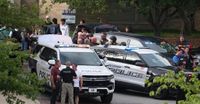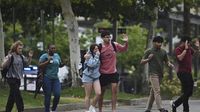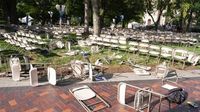It was just another Monday morning on college campuses across the United States—until the familiar ping of an emergency alert shattered the routine. For Miceala Morano, a 21-year-old journalism student at the University of Arkansas, the message was chilling: "Run! Hide! Fight!" Instinctively, she scrambled for cover behind a green screen in her broadcast room, clutching her phone and dialing her grandmother. "As of right now, I’m safe. I love you," Morano assured, her voice trembling with uncertainty, according to the Associated Press.
But the threat that sent Morano and thousands of others into lockdown was, in the end, a hoax. It was just one of a rash of so-called "swatting" incidents—false reports of active shooters—sweeping college campuses as the new academic year began in August 2025. The phenomenon, once rare, has now reached what law enforcement officials call a crisis level, prompting urgent warnings and a scramble for solutions nationwide, as reported by ABC7 and AP News.
On August 25, 2025, investigators chased down six separate active shooter calls at universities including Arkansas, Northern Arizona University, Iowa State, Kansas State, University of Colorado-Boulder, and University of New Hampshire. The day before, the University of South Carolina received two calls reporting a shooter at the school’s library—gunshots echoing in the background. The following day, more hoax calls rattled the University of Kentucky, West Virginia University, and Central Georgia Technical College. According to the Associated Press, these incidents sent waves of fear through student bodies and faculty, many of whom rushed for cover or barricaded themselves in classrooms, following protocols drilled into them since childhood.
At Villanova University outside Philadelphia, the panic began on August 21, 2025, during Orientation Mass. Multiple calls reported a man opening fire with an AR-15 style weapon, accompanied by the sound of gunfire. Students sprinted for safety, some cowering in the library for nearly an hour as police and even a sniper responded to the supposed threat. Ryan Scanlon, a Villanova senior who had lived through the aftermath of the Parkland shooting as an eighth grader, reflected, "It’s really not funny. If you experience that real thing, you never know what can happen next." (AP News)
The fear generated by these hoaxes is real. Officers, donning bulletproof vests and searching for intruders, swarmed campuses across the country. "These officers came from all over this area thinking that they were going to go into an active shooter room, into a building, and have to take somebody down to save someone's life," explained Delaware County District Attorney Jack Stollsteimer, as quoted by ABC7. Chattanooga Police Chief John Chambers echoed the gravity: "Our response is going to, especially our initial response, is going to be the same no matter what. It has to. Lives depend on it. We can never assume that something is fake, right?"
But as the dust settled, the truth emerged: none of the threats were real. Instead, they were part of an escalating wave of swatting calls targeting educational institutions. The aim of swatting, according to AP News, is to provoke a heavy police response—often by a SWAT team—to a fabricated emergency. In a nation still reeling from real mass shootings, these hoaxes exploit deep-seated fears, sap law enforcement resources, and, at worst, can have deadly consequences. In 2017, for instance, a man in Wichita, Kansas, was killed by police responding to a hoax emergency call.
The technical sophistication behind these calls is growing. Law enforcement experts, including Derek Mayer (ABC7), describe the challenges: Are these the work of a single perpetrator or a coordinated group? Are the calls coming from burner phones, regular cell phones, internet sources, or even using AI to disguise voices? As Fred Posner, a telephony consultant, told AP News, "Advances in technology have made it easier for people making such swatting calls to conceal their identities." He added, "The only way for this to stop is to have some sort of enforcement and crackdown against the carriers that continually allow this to occur." The ease with which phone numbers can be obtained and used anonymously only complicates investigations.
The FBI is now working closely with local law enforcement agencies to track down those responsible. While the agency has provided few details about the current wave of campus threats, it notes that similar incidents in the past were believed to have originated from outside the country. The National Association of Attorneys General released a study in August 2025 highlighting the need for stricter and more specific state laws to address and prosecute such false threats, as reported by ABC7.
The emotional toll on students and staff is profound. Mya Norman, a chemistry instructor at the University of Arkansas, recounted hiding under her desk, trembling as the campus remained in lockdown. "We live in tornado alley where people go hear a tornado warning and go outside to look," she told AP News. "So it does concern me that we could end up with that kind of an effect." Security experts like Ken Trump, president of National School Safety and Security Services, warn that repeated hoaxes could breed complacency—students and staff might begin to dismiss real warnings, putting lives at risk. "Campus officials face a delicate balance in keeping students and teachers on guard, but not panicked, for any real threats in the future," Trump explained.
The psychological scars can linger long after the all-clear is given. Casey Mann, a 19-year-old student at Arkansas who hid alongside Morano, admitted she couldn’t sleep until 2 a.m. after the lockdown. "It’s just a scary reality the time we’re living in right now," she said, her voice breaking. "It just makes me wonder what we’re supposed to expect in the future." Even as authorities reassure students and parents that campuses are safe, the memory of those terrifying moments is hard to shake.
Officials are united in their determination to hold perpetrators accountable. "My office, Criminal Investigation Division, the FBI, we're all going to work to try to get to the bottom of who might have done this because if this was indeed a cruel hoax, this is a crime, and we will track you down if it's the last thing we do," Stollsteimer vowed (ABC7). South Carolina Governor Henry McMaster compared the calls to yelling fire in a crowded theater, warning, "It could have been a lot worse than it was. Maybe next time it will be worse."
As the fall semester unfolds, the challenge for universities and law enforcement is clear: keep campuses safe, respond decisively to every threat, and find the right balance between vigilance and calm. The hoaxes may be fake, but the fear—and the need for solutions—is all too real.






